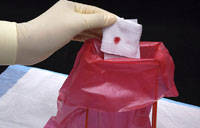 |
|
A worker in a hazardous material suit steps out of an apartment unit where a man diagnosed with the Ebola virus was staying in Dallas, Texas, October 5, 2014. The first Ebola patient diagnosed in the United States took a turn for the worse on Saturday, slipping from serious to critical condition in a Dallas hospital, as health officials reported tracking scores of possible cases around the country that proved to be false alarms. [Photo/Agencies] |
 |
| Chinese medics train Sierra Leone health workers |
 |
| US military to ramp up Ebola mission in Liberia |
 |
| US hospitals unprepared to handle Ebola waste |
Those numbers are based on air traffic remaining at full capacity. Assuming an 80 percent reduction in travel to reflect that many airlines are halting flights to affected regions, France's risk is still 25 percent, and Britain's is 15 percent.
"It's really a lottery," said Derek Gatherer of Britain's Lancaster University, an expert in viruses who has been tracking the epidemic - the worst Ebola outbreak in history.
The deadly epidemic has killed more than 3,400 people since it began in West Africa in March and has now started to spread faster, infecting almost 7,200 people so far. Nigeria, Senegal and now the United States - where the first case was diagnosed on Tuesday in a man who flew in from Liberia - have all seen people carrying the Ebola haemorrhagic fever virus, apparently unwittingly, arrive on their shores.
France is among countries most likely to be hit next because the worst affected countries - Guinea, Sierra Leone and Liberia - are French-speaking and have busy travel routes back, while Britain's Heathrow is one of the world's biggest travel hubs.
France and Britain have each treated one national who was brought home with the disease and then cured. The scientists' study suggests that more may bring it to Europe not knowing they are infected.
"If this thing continues to rage on in West Africa and indeed gets worse, as some people have predicted, then it's only a matter of time before one of these cases ends up on a plane to Europe," said Gatherer.
Belgium has a 40 percent chance of seeing the disease arrive on its territory, while Spain and Switzerland have lower risks of 14 percent each, according to the study first published in the journal PLoS Current Outbreaks and now being regularly updated at http://www.mobs-lab.org/ebola.html.
The World Health Organisation (WHO) has not placed any restrictions on travel and has encouraged airlines to keep flying to the worst-hit countries. British Airways and Emirates airlines have suspended some flights.
But the risks change every day the epidemic continues, said Alex Vespignani, a professor at the Laboratory for the Modeling of Biological and Socio-Technical Systems at Northeastern University in Boston who led the research.
"This is not a deterministic list, it's about probabilities - but those probabilities are growing for everyone," Vespignani said in a telephone interview. "It's just a matter of who gets lucky and who gets unlucky."
The latest calculations used data from October 1.
"Air traffic is the driver," Vespignani said. "But there are also differences in connections with the affected countries (Guinea, Liberia and Sierra Leone), as well as different numbers of cases in these three countries - so depending on that, the probability numbers change."
Relates stories:
